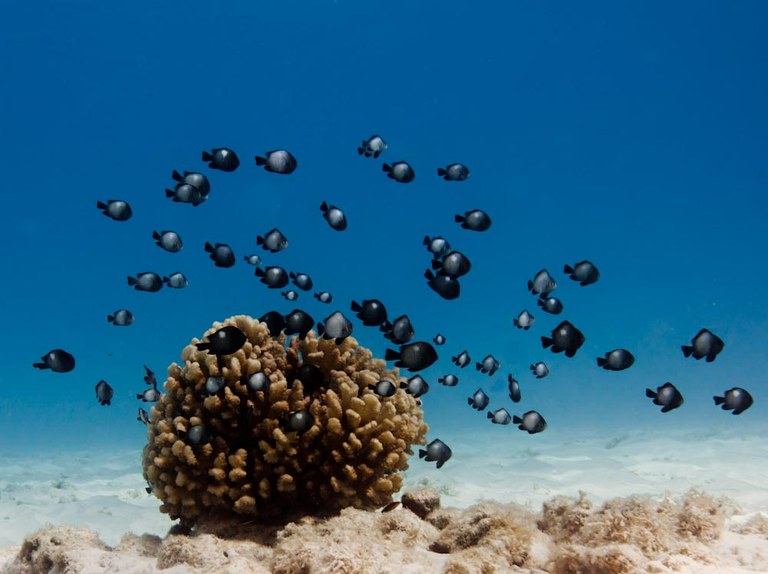
This small colony of cauliflower coral (Pocillopora meandrina), located in the French Frigate Shoals, hosts more than a hundred endemic Hawaiian Domino Damselfish (Dascyllus albisella). Photo by Lindsey Kramer/U.S. Fish and Wildlife Service.
MELBOURNE, FLA.—Climate change drove coral reefs to a total ecosystem collapse lasting thousands of years, according to a paper published this week in Science. The paper shows how natural climatic shifts stopped reef growth in the eastern Pacific for 2,500 years. The reef shutdown, which began 4,000 years ago, corresponds to a period of dramatic swings in the El Niño–Southern Oscillation (ENSO). “As humans continue to pump greenhouse gases into the atmosphere, the climate is once again on the threshold of a new regime, with dire consequences for reef ecosystems unless we get control of climate change,” said coauthor Richard Aronson, a biology professor at Florida Institute of Technology.
Doctoral student Lauren Toth and Aronson, her adviser at Florida Tech, led the study of how past episodes of climate change influenced tropical reefs of the eastern Pacific. Toth, Aronson and a multi-institutional research team drove 17-foot, small-bore aluminum pipes deep into the dead frameworks of coral reefs along the Pacific coast of Panama and pulled out cross-sections of the reefs. By analyzing the corals in the cores, they were able to reconstruct the history of the reefs over the past 6,000 years.
“We were shocked to find that 2,500 years of reef growth were missing from the frameworks,” said Toth. “That gap represents the collapse of reef ecosystems for 40 percent of their total history.” When Toth and Aronson examined reef records from other studies across the Pacific, they discovered the same gap in reefs as far away as Australia and Japan.
Toth linked the coral-reef collapse to changes in ENSO. ENSO is the climate cycle responsible for the weather conditions every few years known as El Niño and La Niña events. The timing of the shutdown in reef growth corresponds to a period of wild swings in ENSO. “Coral reefs are resilient ecosystems,” said Toth. “For Pacific reefs to have collapsed for such a long time and over such a large geographic scale, they must have experienced a major climatic disturbance. That disturbance was an intensified ENSO regime.”
Scenarios of climate change for the coming century echo the climate patterns that collapsed reefs in the eastern Pacific 4,000 years ago. The reefs off Panama are on the verge of another collapse. “Climate change could again destroy coral-reef ecosystems, but this time the root cause would be the human assault on the environment and the collapse could be longer-lasting,” said Aronson. “Local issues like pollution and overfishing are major destructive forces and they need to be stopped, but they are trumped by climate change, which right now is the greatest threat to coral reefs.”
Toth noted more hopefully that reefs have proven resilient in the past, so the potential for recovery should be good if climate change can be mitigated or reversed.
(press release Florida Institute of Technology)









0 Comments